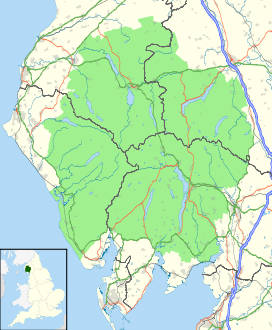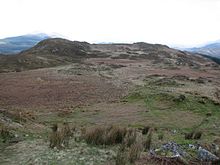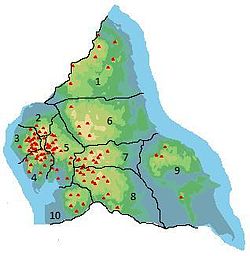- Muncaster Fell
-
Muncaster Fell 
The view west from Hardknott Pass in upper Eskdale, toward Muncaster Fell.Elevation 231 m (758 ft) Prominence 193 m (633 ft) Parent peak Illgill Head Listing Marilyn, Outlying Wainwright Location Cumbria,  England
EnglandRange Lake District Coordinates 54°22′21″N 3°21′50″W / 54.37249°N 3.36382°WCoordinates: 54°22′21″N 3°21′50″W / 54.37249°N 3.36382°W Topo map OS Landranger 89/96, Explorer OL6 OS grid SD115983 Muncaster Fell is a fell at the far western edge of the Lake District National Park, in Cumbria, England. Muncaster Fell is a long, narrow ridge of land, approximately 1.2 km wide and 6 km long, lying between the River Mite to the north, and River Esk to the south. The fell rises from the coast near Ravenglass village to its highest point at Hooker Crag (231 m). The ridge then continues to the north-east, dropping gently to its furthest prominence at Silver Knott (174 m). The fell then falls away rapidly to the village of Eskdale Green at its north-eastern tip.
Contents
Landscape
The fell forms a long, low, yet steep-sided ridge that separates the southern portions of the valleys of Miterdale and Eskdale. The north-western slopes of the fell are characterised by steep crags and scree slopes, which drop abruptly to the fluvial floor of the Mite valley. The narrow-gauge Ravenglass and Eskdale Railway tracks cling to the lower sides of this rocky face. The south-eastern, Eskdale slopes are not much less steep, but are shallow enough to allow the cultivation of a number of forestry plantations. Woodland abounds at the southernmost tip of the fell, with both natural deciduous woodland and invasive rhododendron stands competing for space. On the very south-western point of the fell stands Muncaster Castle, its grounds planted with a wide variety of plant species, including a dense copse of bamboo.
On the fell top the vegetation and landscape typifies the Cumbrian fell. A small tarn, Muncaster Tarn (GR: SD107978), sits amongst woodland on the slopes below the top of Hooker Crag. Much of the area between the crags and bogs is covered by moss, gorse, sedge and small clumps of bilberry bushes. In recent times, in common with much of the Lake District upland area, bracken has begun to take over, possibly due to a reduction in the number of sheep grazing on upland pasture.
Along the southern end of the fell ridge runs a straight track, climbing up past the tarn toward Hooker Crag. This is part of a Roman road which used to connect the large fort of Glannaventa near Ravenglass on the coast, approximately 2 km away, to the garrison at Hardknott Fort (know to the Romans as Mediobogdum), 14 km to the north-east. Although the rest of the route along the ridge top has been lost, there is a small, low dolmen, which despite its stone age appearance is inscribed Ross's Camp 1883 on the top surface (GR: SD121987).
Geology
Muncaster Fell is composed almost entirely of granite and microgranite, belonging to the Ordovician Eskdale Group. At the south-western end of the fell, between Ravenglass village and Muncaster Castle, is a restricted outcrop of hornfelsed lower Ordovician siltstones and sandstones, belonging to the Skiddaw Group, and andesite of the Borrowdale Volcanic Group.
Owing to its relatively steep-sided profile the fell is largely free of drift geology. The lowest slopes are generally covered in glacial diamicton derived from the igneous lithologies nearer the centre of the Lake District, and the steeper crags give rise to localised scree deposits. Between the crags along the top of the ridge small peat bogs are developed, the largest of these being Hooker Moss (GR: SD113984).
References
- Akhurst, M.C.; Chadwick, R.A.; Holliday, D.W.; McCormac, M.; McMillan, A.A.; Millward, D.; & Young, B. (1997). Geology of the west Cumbria district. Memoirs of the British Geological Survey, sheets 28, 37, 47 (England and Wales). British Geological Survey. Keyworth, Nottingham. pp. 138
- British Geological Survey (1996). Ambleside. England and Wales Sheet 38. Solid Geology. 1:50 000. British Geological Survey. Keyworth, Nottingham. ISBN 0-7518-2889-0
- Moseley, F. (Ed.) (1990). The Lake District (2nd ed.). Geologists' Association Guide No. 2. The Geologists' Association. pp. 213 ISBN 0-900717-73-4.
External links
Major summits; Beacon Fell · Black Combe · Blawith Knott · Brunt Knott · Buck Barrow · Burney · Carron Crag · Claife Heights · Cunswick Scar · Dent · Gummer's How · Faulds Brow · Green Quarter Fell · High Wether Howe · Knipe Scar · Muncaster Fell · Orrest Head · Scout Scar · Stickle Pike · Top o'Selside · Watch Hill · Whitbarrow · Whitfell · Yoadcastle ·Categories:- Fells of the Lake District
- Wainwrights
- Marilyns of England
Wikimedia Foundation. 2010.



